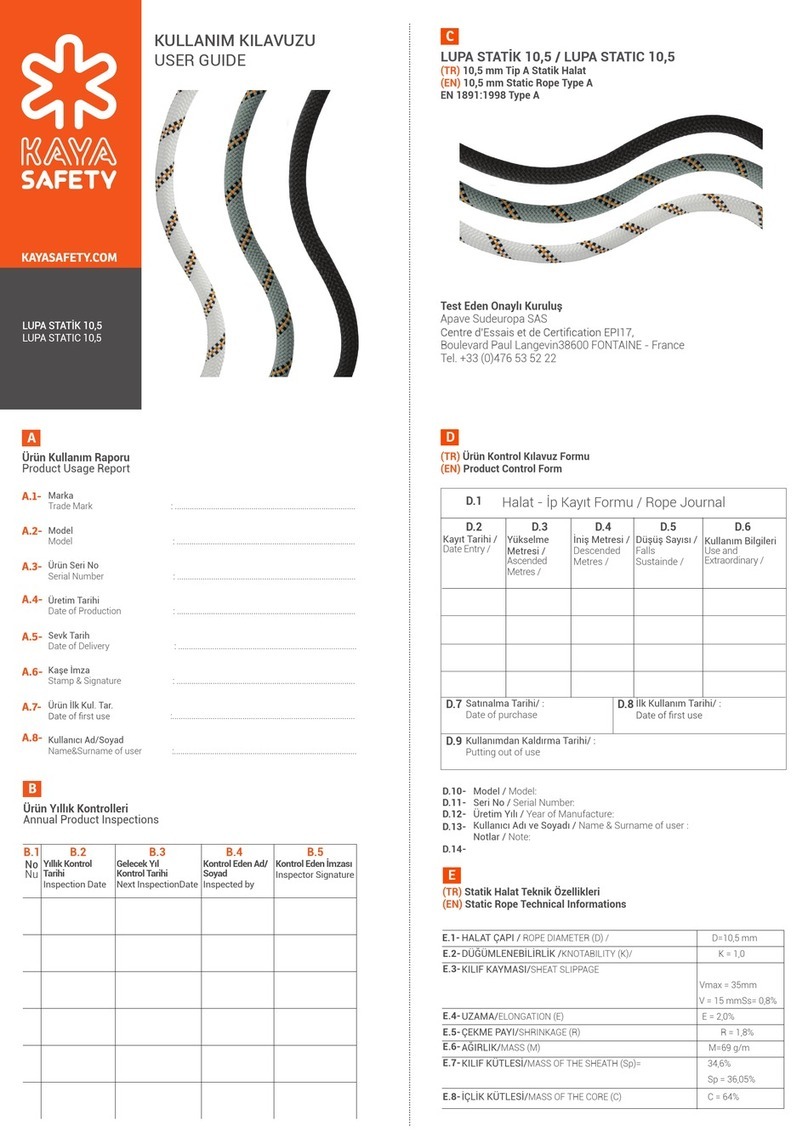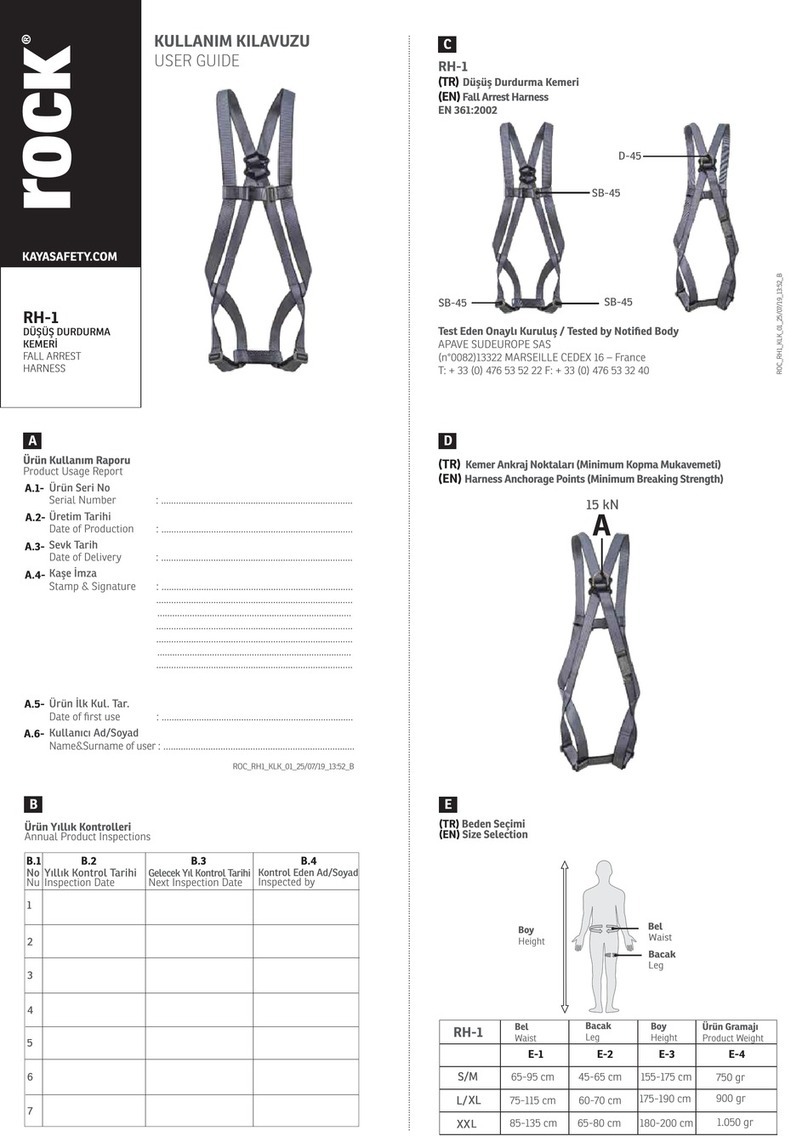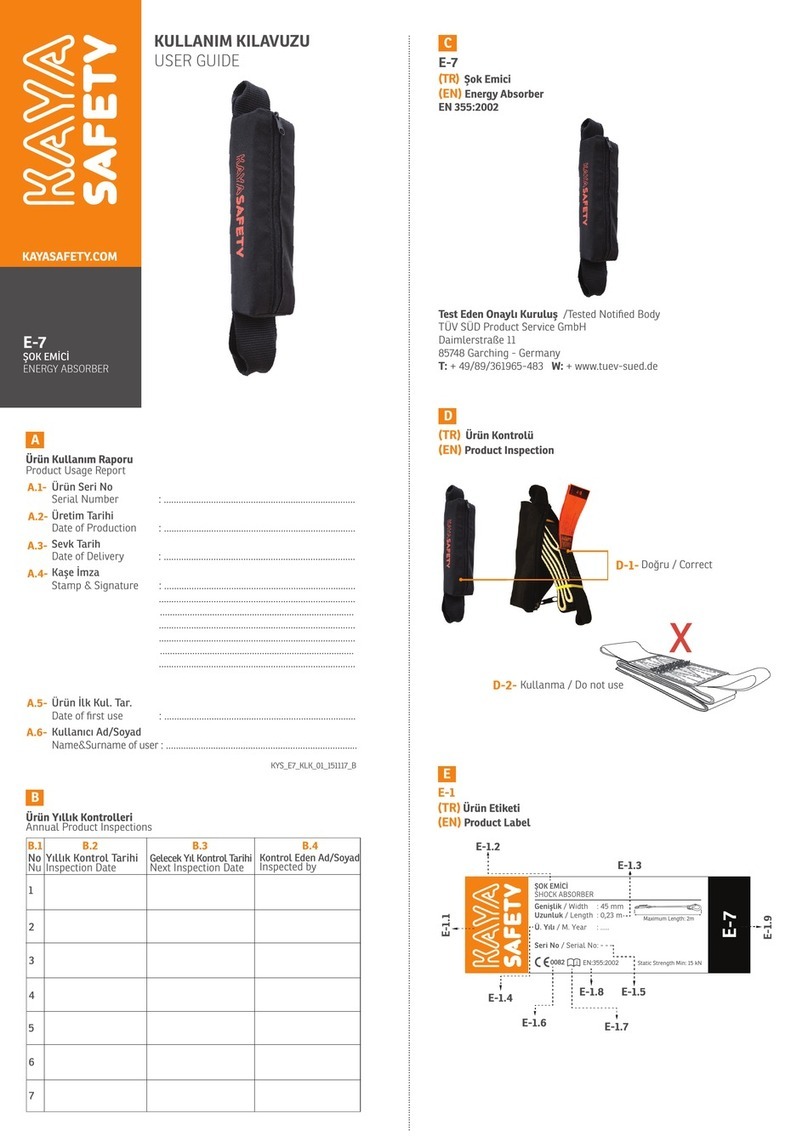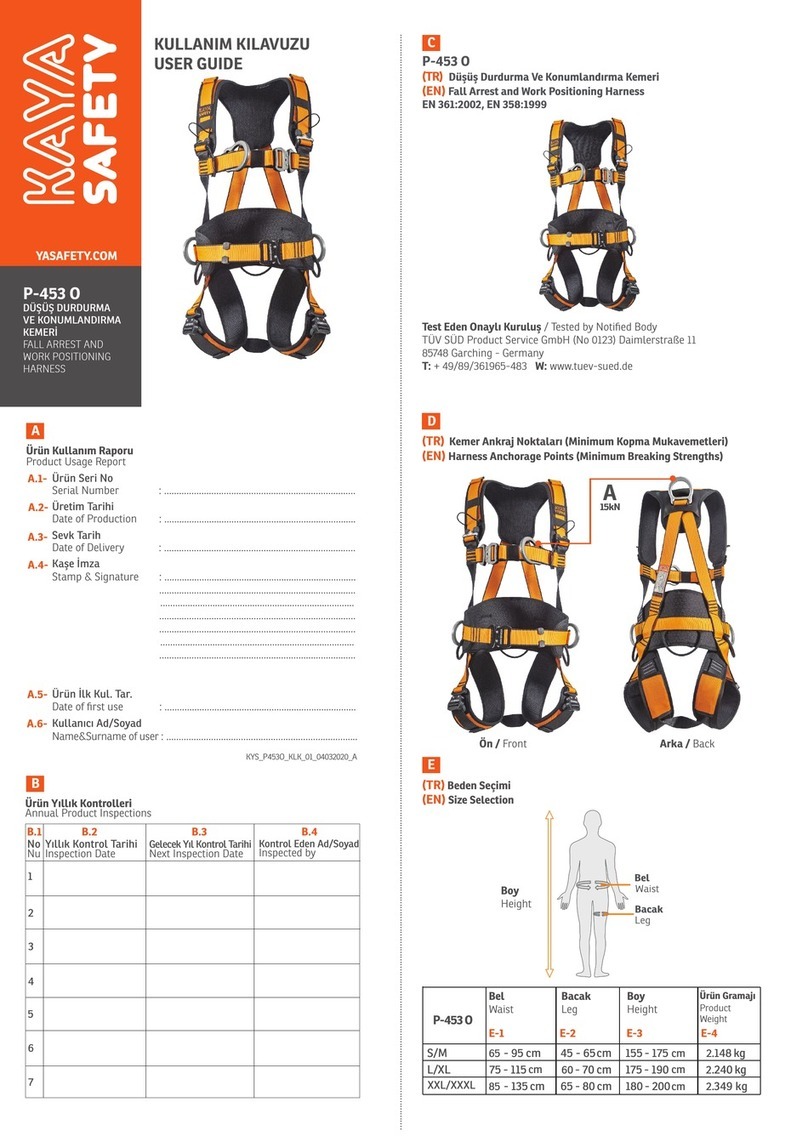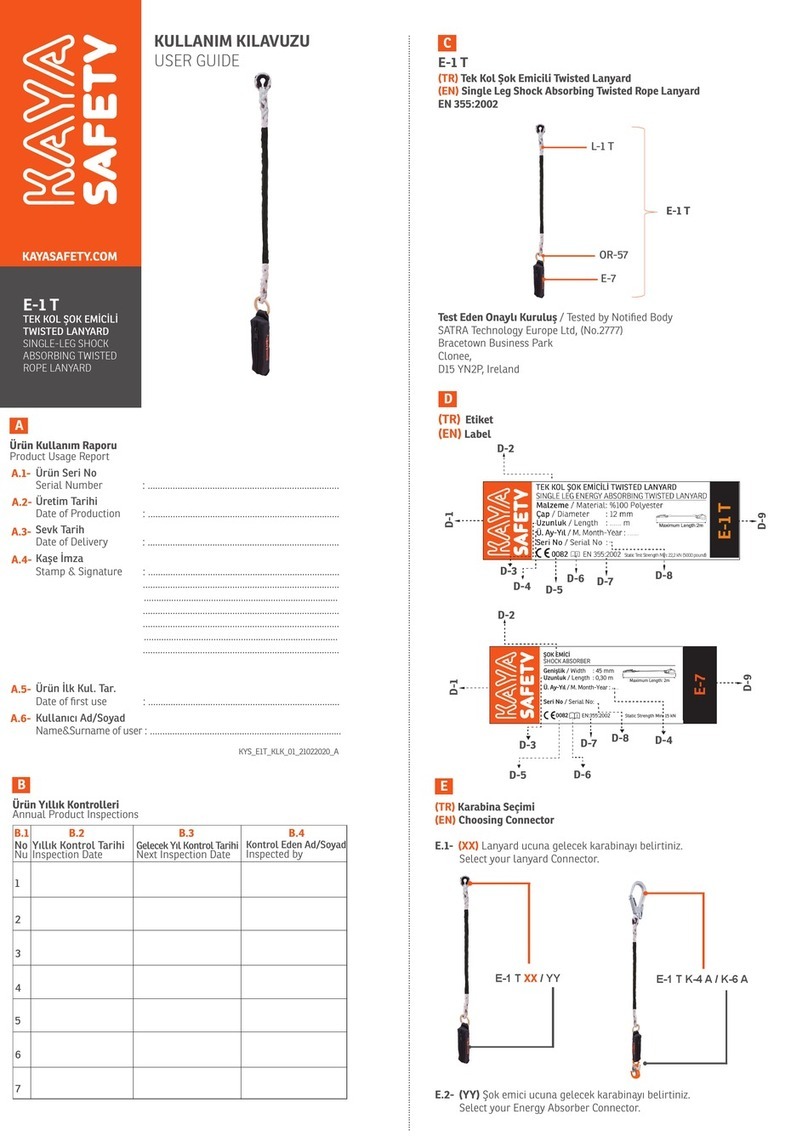
.........................................................................................................................................................................................................................................................................................................................................................................................................................................................
1- Usage Area
*Personal Protective Equipment (PPE)
*Vertical Lifeline System is a permanent system and can be installed on
a vertical ladder or similar structures
*Vertical Lifeline System provides users hands free fall protection on
ladders and other climbing tools by creating continuous access to suitable
anchorage points
* This system is not designed for weight-lifting purposes.
*Vertical Lifeline System is manufactured and certified in accordance with
2016/425 EU regulation and EN 353-1:2014+A1:2017 norm
*Operating Temperature for Lifeline and rope Grab is minimum -30°C
2- Responsibility
*Working at height is acknowledged as one of the most dangerous
activities that cause fatal accidents. Prior to use, the user must read and
understand the user guide and be properly trained by their employer prior
to use. Failure to follow all instructions and limitations on the use of the
Vertical Lifeline System may result in serious personal injury or death. The
guide should not be considered as any form of training.
* A full body harness is the only acceptable body holding device that can be
used in a fall arrest system.
*The guided type fall arrester (Rope Grabe) should be connected to a
full body harness conforming to EN 361equipped with a front fall arrest
attachment point, including a clear statement on the required position of
the harness attachment point.
3. Installation
Vertical Lifeline System must be installed by competent persons who have
working at height training certificate and have been trained & authorized by
KAYA for installation. KAYA will not be liable for any installation performed
by unauthorized person. Please refer to installation manual for installation
instructions.
* Tested only on sideways angle at 15°.
* A full body harness is the only acceptable body holding device that can be
used in a fall arrest system
4- Product Usage (EN 353-1:2014+A1:2017)
*Vertical Lifeline System is designed for use only one user.
*If the system is planned to be used in areas where the environmental
hazards are concerned users must take extra precautions to prevent himself
from possible injuries or to protect equipment from damage. Environmental
hazards can be listed as high temperature caused by welding or metal
cutting, sea water, high voltage power lines, explosive or toxic gases, caustic
chemicals, moving machinery, and sharp edges
* The minimum load must be at 50kg without equipment.
* The maximum load must be at 150kg with equipment.
*System should not be used by users who’s total weight (including clothing,
tools, etc.) is less than 50 kg.
*Vertical lifeline has integrated energy absorber RA-50 S. Make sure that
RA-50 S energy aborber has not experienced any shock and it is in working
condition.If the system experienced a fall red colour indicator on the energy
abosrber appears. In this case system must not be used untill RA-50 S energy
absorberis replaced.RA-50 S energy absorber is replaced.
4.1 Connecting Rope Grab onto Full Body Harness
* A guided type F-5 Rope Grab (fall arrester) must be used when working on
the Vertical Lifeline
* F-5 fall arrester must be used with orginal K-2 /3ACP type carbine full
body harness should be connected to a full body harness conforming to EN
361equipped with a front fall arrest (A) attachment point, including a clear
statement on the required position of the harness attachment point
* Full body harnesses should be properly adjusted to fit the body before each
use.
* The full body harness should be properly adjusted to a snug fit and should
not be used if loose
* If the harness becomes loose during ascent or descent, it should be correctly
adjusted again to a secured position
* The length of the connecting element shall not be extended or shortened,
e.g. by adding or subtracting aconnector.
4.2 Installing Rope Grab
* K-2030 A Vertical life line have a shock absorber on the line and a F-5 fall
arrester should beused with this model
* F-5 fall arester as shown should be installed and removed on the line as
shown in Figure-1,
* The arrow on the rope grab must point upward.
* Rope Grab is a personal equipment and so it needs to be removed from the
system after each use. If it is left on the system, it may not work properly due
to environmental sources such as dust, dirt, oil, chemicals etc.
4.3 Climbing with Rope Grab
* To ascend with a F-5 Rope grab climb up the ladder normally. The
detachable rope grab will follow the user.
*Use caution when climbing. Avoid carrying tools or equipment that do not
allow your hands to be free for climbing. Ensure items are carried securely
to drop below.
*Climb within your ability. Long climbs may require several rest stops
during ascent or descent to avoid exhaustion.
*Avoid climbing in high winds or severe weather whenever possible.
*To descend, climb down smoothly in a normal position.
*Allow the detachable rope grab to lead the user down.
*Climbing down out of position (leaning back excessively) will cause the
detachable rope grab to lock on the cable. If the detachable rope grab
locks, move upward slightly to release, then continue down the ladder.
*When climbing is completed and the user is in a safe location remove the
carabiner from rope grab and remove the rope grab from the cable.
4.4 Fall Clearance
For equipment intended for use in fall arrest systems, it is essential for
safety to verify the free space required beneath the user at the workplace
before each occasion of use, so that, in the case of a fall, there will be no
collision with the ground or the other obstacle in the fall path.
*A minimum fall clearance of 2 meters is required between the user’s
feet and surface below. The user may not be protected against hitting
the ground or landing during the first 2 meters of ascent or 2 meters of
descent.(Figure-2)
*Use proper climbing procedures (e.g., maintain 3 points of contact with
hands and feet) when ascending or descending any portion of the ladder
unprotected by the system.
4.5 Work Positioning
* Rope Grab should not be used as work positioning purpose.
*If the work positioning is required on the system, additional relevant
equipment needs to be used such as WPL Work Positioning Lanyard.
*There are hazards associated with connecting and disconnecting from
the system. Use secondary fall arrest protection. Ensure adequate anchor
points, landing platforms, or other means are available at connection and
disconnection points to allow safe transitions to and from the system.
* Identify hazards in the work area that could cause injury to the user or
damage to the system, such as: high heat, electrical hazards, chemical
hazards, falling objects, or moving machinery.
5 General information on the EN 365 standard
5.2.1 Rescue Plan
*The user must have a rescue plan in place and the ability to implement
the plan and to communicate that plan to users, authorized persons, and
rescuers in the event of a fall.
5.2. 2 Anchorage Point
* Anchorages to which personal fall arrest equipment is attached should
always be placed above the position of the user and shall be capable of
supporting 12 kN (EN 795) per employee attached.
5.2.3 General Warnings
*Compatibility of different fall protection equipment must be considered as
it can result in a dangerous situation
*A verticcal life line and fall arrester is intended for use as a component in
a personal fall arrest system.
*There must be sufficient clearance below the user to arrest a fall before
the user collides wtih the ground or any other obstacle. Thus, the user
must check for enough free space on each use.
*The user must be medically fit condition to use the equipment
6. Control and Validation
6.1 Before each use:
All components of the Vertical Lifeline shall be inspected by the authorized
person or rescuer prior to each use. Additionally, annual inspections shall
be conducted by a factory authorized “competent person” other than the
user. Findings should be recorded in the “Inspection and Maintenance Log”
.Inspection must be performed based on following criterias;3
* All markings must be legible and attached to the product.
* All equipment must be free of corrosion, chemical attack, alteration,
excessive heating or wear.
* All hardware shall be free of cracks, sharp edges, deformation, corrosion,
or any evidence of defect or damage to.
* Cable must be inspected for kinks, broken strands, corrosion, abrasion, or
other signs of wear and damage.
* Energy absorber in line should be use.







